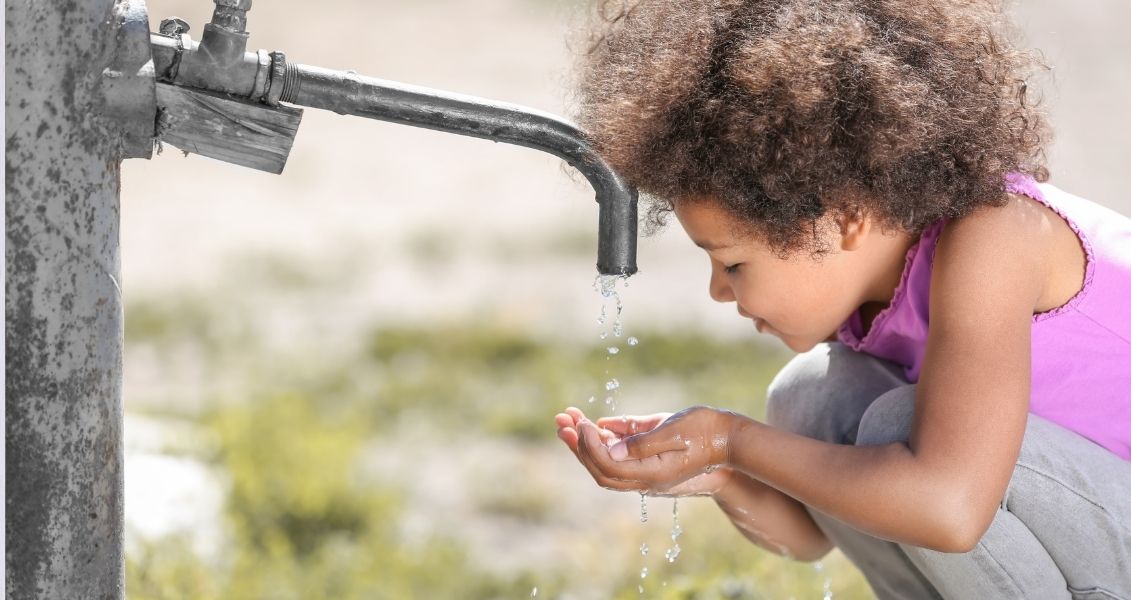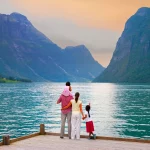World Water Day
What day is it?
Earth is often called the “blue planet”, referring to its vast expanses of water. However, 97% of it is seawater, unfit for human consumption. Although the share of fresh water is small compared to salt water, it is vitally necessary for us to drink, cook, and sanitary needs. Due to the growth of the population, the development of production, and climate change, there is a shortage of fresh water, and many people in the world have already felt it. In order to unite international efforts in the fight against the water crisis and encourage the population to use water more efficiently, the UN founded World Water Daywhich is celebrated every year on March 22.
How did the idea to celebrate World Water Resources Day come about?
In the most ancient times, people led a nomadic lifestyle, engaged in hunting or gathering, and did not have permanent settlements. However, when choosing a place for a temporary stop and rest, they preferred places near fresh water bodies – rivers or lakes. Later, our ancestors began to sow the land with agricultural crops, which led to a sedentary life, the appearance of settlements and cities. One of the key factors in the well-being of a particular settlement was the availability of a sufficient amount of drinking water, preferably within easy reach.
Usually, cities were built on the banks of rivers and lakes, and in cases of further location from fresh water bodies, wells were dug to take water from underground sources. They also tried to collect rainwater for household needs. But for farming, this was often not enough, so people learned to build water channels. The first such structures belong to Babylon, Assyria and Egypt. At first, these were simply open channels between the river and the city.
An interesting monument left behind by the ancient Incas near the city of Cuzco in Peru is a system of aqueducts between waterfalls that originate in thermal springs on the mountain slopes and the city. The water was piped directly to the houses, and archaeologists assume that the inhabitants of that ancient city took a hot bath right in their homes.
The most famous aqueduct engineers among ancient civilizations were the Romans. For 500 years, 11 aqueducts were built in the capital of the empire alone, which delivered water to Rome from a distance of 92 kilometers, and the total length of the system was 415 kilometers. Stones, wood, bronze, silver and lead were used as materials for water fountains.
Clean water is the key to health
Methods of water purification, such as heating and filtering, are mentioned as far back as ancient Indian Sanskrit chronicles. The ancient Greek physician Alcmeon was the first to state the connection between water quality and human health. Hippocrates was of the same opinion – in his work “Air, Water and Terrain”, the healer analyzed the quality of water from different places. Clear, tasteless and odorless water was considered the best. Despite the fact that microorganisms or chemical compounds were not yet known, water from stagnant ponds and swamps was not recommended to drink, and water from springs near places of underground mineral extraction was also considered dangerous.
During the Middle Ages, the ancient culture of using water was almost forgotten. The townspeople threw waste into streams and canals, and they carried it to the river. Therefore, aqueducts built from the nearest rivers carried water contaminated with sewage to the cities. Due to the use of such water, people often fell ill with infectious diseases. Only water from reservoirs far from the city was clean, but it had to be delivered to someone, so the profession of water carriers appeared.
Water purification
Filtration as a means of obtaining clean drinking water began to be used en masse in the 17th and 18th centuries. For this, a system of several sand filters was used, through which water passed alternately. In 1703, the French Academy of Sciences considered the possibility of installing a rainwater tank and a sand filter in every house in Paris.
But only a hundred years later, in 1804, the world’s first municipal water treatment plant appeared in the Scottish city of Paisley. Since then, water purification systems have been installed in other cities and countries. In the middle of the 19th century in London, a decrease in mortality from cholera was noted after the water for the city began to be filtered in a mandatory manner.
Soon, sensory assessment of water quality was supplemented by chemical and microbiological studies. In the world, more effective methods of cleaning large volumes of water were invented and implemented, and from the beginning of the 20th century, chlorination was additionally used. It seemed that health problems from drinking contaminated water remained relevant only for the poorest countries.
But during the 20th century, the world population increased 4 times, and the population in cities increased 13 times. The volumes of industry and consumption of various types of energy have increased several dozen times. Accordingly, the pollution of air, soil and water by chemical and radioactive substances has increased. 80% of all wastewater on Earth returns to the ecosystem without treatment. In addition, the production of agricultural products is very water-intensive, it consumes 70% of all fresh water. For example, 3,000 liters are used to produce one kilogram of rice.
As a result, the world is increasingly experiencing a shortage of fresh water. 80% of people who have these difficulties now live in African countries. But according to forecasts, by 2025, 35% of the world’s population in 48 countries will experience a lack of drinking water.
World Water Day in history
-
1992At the UN Conference on Environment and Development, which was held in Rio de Janeiro, the idea to establish an international day dedicated to water problems arose. In the same year, the UN General Assembly, by its resolution, approved March 22 as the annual World Water Day.
-
1993
March 22World Water Day was celebrated for the first time in the world. -
1995The “Water Code of Ukraine” entered into force, which together with the Law “On Environmental Protection” regulates the norms of water resources use in our country.
-
1996An international organization was created to mobilize actions to overcome critical water problems – the World Water Council with headquarters in the French city of Marseille.
-
2013It was declared by the UN as the International Year of Cooperation in the Water Sector.
-
20182018 – 2028 The UN declared these 10 years the International Decade “Water for Sustainable Development”.
Frequent Questions and answers on World Water Day
Water vapor from the surface of the oceans rises to the clouds, from where it returns as rain or snow. These precipitations are collected in rivers, ponds, lakes and swamps according to the earth’s landscape. Part of the fresh water seeps underground, filling cracks and voids – this is how groundwater is formed.
Water is the second most important factor for human life after air. It is a universal solvent and transport medium, that is, the basis of all biological processes in the body. Water is also important for regulating body temperature. A person can live without water for only a few days, while without food – about a month.
One liter of sea water contains approximately 34 grams of salt. To remove this amount of salt from the body, our kidneys use one and a half liters of water. Thus, the use of sea water leads a person to rapid dehydration.
Yes, in some industries it is possible. For example, in the USA, sea water is used to cool equipment in the process of electricity production, as well as in the mining industry.
What are the largest freshwater lakes on the planet?
The first largest is a lake called Verkhnye, located in the North American Great Lakes system. Its area is 82.4 thousand km2. In second place is Victoria in East Africa with an area of 69.5 thousand km2. Lake Huron is the third largest lake among the Great Lakes – 59.6 thousand km2.
How to celebrate World Water Day?
Fresh water makes up 3% of all water reserves on the planet, of which 2% is in the form of glaciers or deep underground. Only 1% of water is available for all human needs. Therefore, the need for careful treatment of water resources is obvious.
In the matter of overcoming the water crisis, a lot depends on government programs and improvement of production processes. But every single person can contribute to the conservation of water, if he thinks about its adequate use in everyday life.
First of all, it is necessary to make sure that the faucets in the house and the toilet tank are not leaking, because about 24 liters of water are lost per day through a dripping faucet. Nozzles-aerators for faucets also allow to reduce the flow of water. To reduce water consumption in the toilet, you can adjust the drain tank or place a plastic water bottle in it. Dishwashers and washing machines use much less water than washing dishes or laundry by hand, and taking a shower is much more economical than filling a bathtub with water.
To conserve water, it is important to plant trees, because it improves the condition of soils that accumulate water and mitigates the effects of climate change. It is better to water the garden, lawn or vegetable garden less often, but more heavily, because with frequent short waterings, the water quickly evaporates from the surface of the earth, without benefiting the plants.
It is also worth choosing goods in stores with a sign of secondary processing, because this process requires much less water than production from primary raw materials.
Why is this event important?
Our country is very rich in water resources. These are large rivers – Dnipro, Danube, Dniester, Southern Bug, Siverskyi Donets, as well as numerous small rivers, ponds and lakes. At the same time, most of the waters are polluted with poorly treated industrial effluents, municipal sewage, and dangerous chemical compounds. Therefore, the water we get from our taps is mostly unfit for consumption in its raw form, and people are forced to buy bottled drinking water, but its quality is also sometimes questionable.
Dams have been built on large rivers, which greatly harms aquatic ecosystems. The number of freshwater fish is constantly decreasing, reservoirs are silting up and thinning, and city river beaches are repeatedly closed every summer due to high water pollution. Unfortunately, Ukrainian legislation has not yet provided adequate responsibility for the pollution of water resources, and in general, this problem is not among the priorities for the authorities.
Ago World Water Day is another reason to pay attention both at the state level and at the level of each person to the necessary actions and measures to ensure that future generations have the opportunity to consume clean water in sufficient quantities.
When will we celebrate World Water Day?
| Year | Date | Weekday |
|---|---|---|
| 2021 | March 22 | Monday |
| 2022 | March 22 | Tuesday |
| 2023 | March 22 | Wednesday |
| 2024 | March 22 | Friday |
| 2025 | March 22 | Saturday |


































